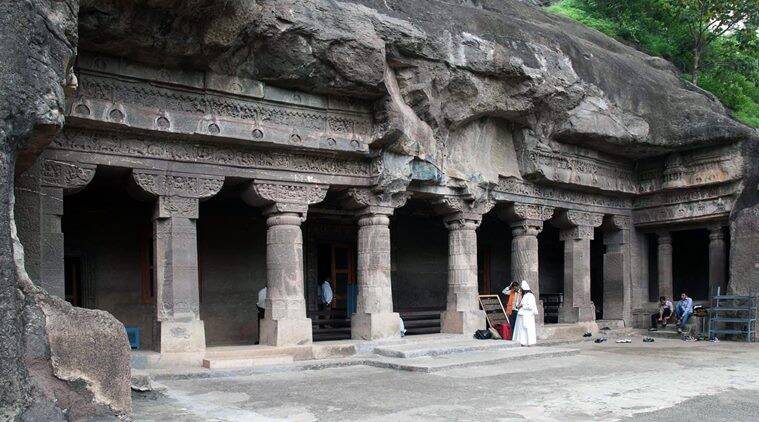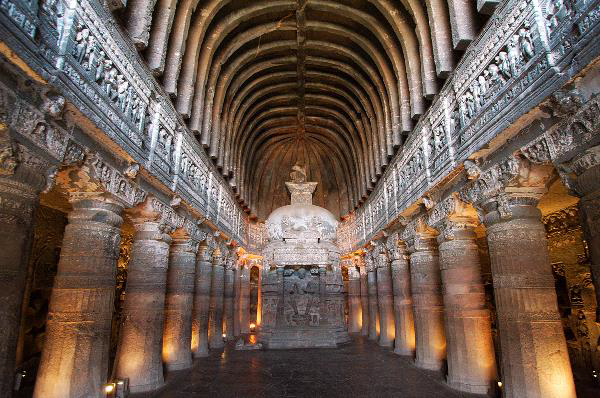
Title: Exploring the Sacred Spaces
Introduction:
The Ajanta Caves, a UNESCO World Heritage site in Maharashtra, India, comprise a remarkable collection of rock-cut Buddhist caves that showcase the artistic and architectural excellence of ancient India. Among the various types of caves found in Ajanta, the Chaityas and Viharas hold immense significance. In this article, we will delve into the intricacies of Chaityas and Viharas, their roles in Buddhist architecture, and the number of such caves present in Ajanta.
Chaitya
A Chaitya is a sacred space in Buddhist architecture, serving as a place of worship and congregation. It represents the symbolic presence of the Buddha and his teachings. Chaityas are characterized by their apsidal (semi-circular) layout, resembling a horseshoe, with a central nave, side aisles, and a stupa at the far end. The stupa, an important Buddhist symbol, symbolizes enlightenment and serves as the focal point of devotion.
Vihara
A Vihara, on the other hand, is a residential space for Buddhist monks, providing accommodation, study areas, and meditation cells. Viharas were essential for the monastic lifestyle and served as centers of learning and spiritual practice. These caves often include cells for individual monks, communal spaces, and courtyards.
Number of Chaityas and Viharas in Ajanta:
Out of the total 30 caves at Ajanta, there are five Chaityas and the remaining caves are Viharas. Let’s explore some of the notable Chaityas and Viharas found in Ajanta:
- Cave 9 (Chaitya):
Also known as the Carpenter’s Cave, Cave 9 is one of the earliest Chaitya halls at Ajanta. It features intricately carved pillars, a semi-circular apse with a stupa, and beautiful sculptures depicting scenes from the life of the Buddha. - Cave 10 (Vihara):
Cave 10 is a spacious Vihara, characterized by its large central hall and numerous small cells surrounding it. The walls of this cave are adorned with paintings showcasing narratives from Buddhist Jataka tales. - Cave 19 (Chaitya):
Cave 19, popularly known as the Chaitya Hall, is one of the most significant Chaityas at Ajanta. It features a grand entrance with a horseshoe-shaped window, a nave, side aisles, and a magnificent stupa at the end. The walls are adorned with exquisite sculptures and paintings depicting various Buddhist motifs and stories. - Cave 17 (Vihara):
Cave 17 is a massive Vihara, notable for its large central hall and intricately carved pillars. The walls of this cave are adorned with beautiful paintings showcasing scenes from the life of the Buddha, Jataka tales, and other Buddhist themes. - Cave 26 (Vihara):
Cave 26, known as the “Prince’s Vihara,” is a significant residential complex for monks. It consists of multiple cells, each with a stone bed and an attached water tank. The walls of this cave also feature captivating paintings, including the famous depiction of the “Prince in Dying Condition.”
Significance of Chaityas and Viharas:
Chaityas and Viharas played crucial roles in the religious and monastic practices of Buddhism. Chaityas provided a space for communal worship, meditation, and the dissemination of Buddhist teachings. The presence of a stupa within the Chaitya served as a focal point for devotion and symbolized enlightenment. Viharas, on the other hand, catered to the monastic community,
offering spaces for study, meditation, and communal living.
Conclusion:
The Chaityas and Viharas of Ajanta Caves stand as magnificent examples of ancient Buddhist architecture and artistic excellence. These sacred spaces served as centers of religious worship, monastic life, and spiritual contemplation. The remarkable craftsmanship and intricate detailing found within these caves provide us with a glimpse into the rich cultural and spiritual heritage of ancient India, offering a profound connection to the teachings and practices of Buddhism.

Infinitely grateful! 💯